Friday, October 24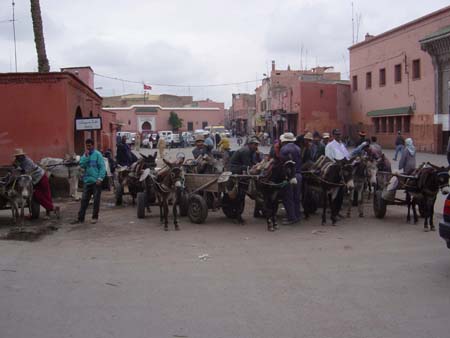
Steve and Paula: The weather was still cool and cloudy
this morning, so we decided to relax and catch up on schoolwork before heading
back into the Medina. Today we arranged to have another guide. We felt like
there was much more for us to see and understand about life in the Medina,
and we've found that this really requires a guide. As it turned out, this
was 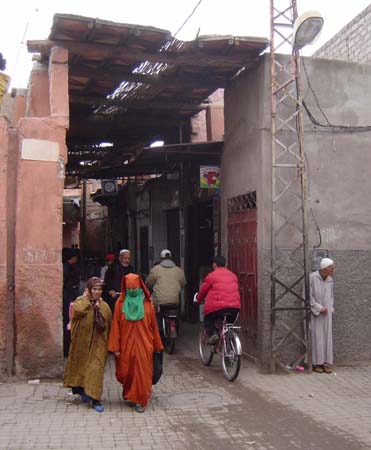 definitely
the right decision for us today. Mustapha was highly recommended to us, and
also has small children. As we quickly learned, Mustapha is very passionate
about Morocco, and extremely knowledgeable about the people here and their
lives. Amazingly, he knows many languages (including Japanese) and says that
he's learned these all from simply interacting with visitors to Marrakech.
As we got started, we told Mustapha that we'd simply like to wander through
the Medina, and to watch and understand how the people here are living.
definitely
the right decision for us today. Mustapha was highly recommended to us, and
also has small children. As we quickly learned, Mustapha is very passionate
about Morocco, and extremely knowledgeable about the people here and their
lives. Amazingly, he knows many languages (including Japanese) and says that
he's learned these all from simply interacting with visitors to Marrakech.
As we got started, we told Mustapha that we'd simply like to wander through
the Medina, and to watch and understand how the people here are living. 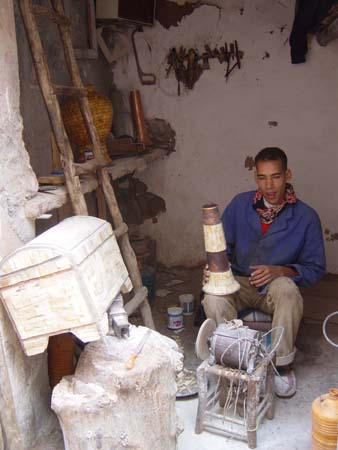
The Medina was easier to navigate today because the rain had stopped and because it was Friday, a holy day for Muslims. We learned that yesterday was the first rain they have had in Marrakech since April! There are only about 65 days of rain a year, and even on these occasions it seldom rains all day - yesterday was an anomaly, but the rain is definitely needed here.
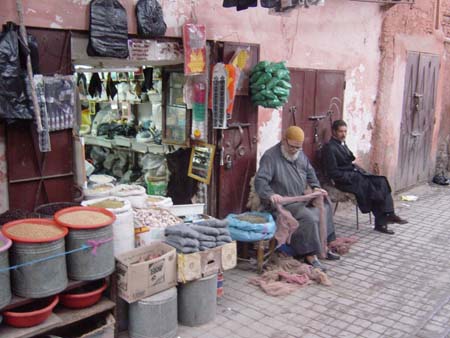 Mustapha
was anxious to help us understand how the people of Marrakech live and work.
We spent a great deal of time today meeting and observing craftsmen in action.
The production of crafts, all done by hand, represents much of the fabric
of Marrakech - Mustapha likes to calls the hands of the craftsmen the "petrol"
of the city. From what we saw, this is an accurate description. As we observed
all the craftsmen today (many more than we saw yesterday), we found ourselves
impressed with the work ethic of the people and the products of their labors.
We watched men making all kinds of crafts with iron, silver, copper and even
the bones of a camel. We saw many men hand stitching the trim on traditional
Mustapha
was anxious to help us understand how the people of Marrakech live and work.
We spent a great deal of time today meeting and observing craftsmen in action.
The production of crafts, all done by hand, represents much of the fabric
of Marrakech - Mustapha likes to calls the hands of the craftsmen the "petrol"
of the city. From what we saw, this is an accurate description. As we observed
all the craftsmen today (many more than we saw yesterday), we found ourselves
impressed with the work ethic of the people and the products of their labors.
We watched men making all kinds of crafts with iron, silver, copper and even
the bones of a camel. We saw many men hand stitching the trim on traditional
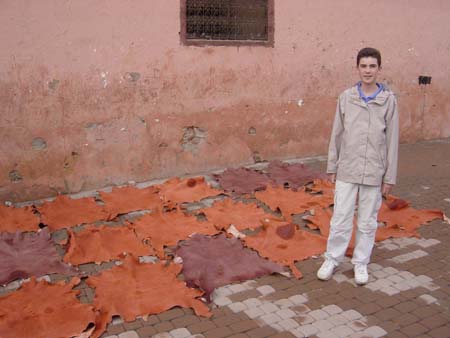 garments and making a variety of leather products. Marrakech is known for
its quality leather, and the hides from sheep, goats and cows are auctioned
in the Medina each morning to the craftsmen who then make products to be sold
in the souqs (in this picture, David's standing next to some of the hides
set out to dry).
garments and making a variety of leather products. Marrakech is known for
its quality leather, and the hides from sheep, goats and cows are auctioned
in the Medina each morning to the craftsmen who then make products to be sold
in the souqs (in this picture, David's standing next to some of the hides
set out to dry).
We again walked through the metal working area, which is clearly some of
the hardest work done here. Most of the workshops here are very small. They're
cement rooms located on the streets or in special areas called Fondouks (these
used to be inns for traders, but now served as workshops). The working conditions
are not comfortable, but the people are very focused on their c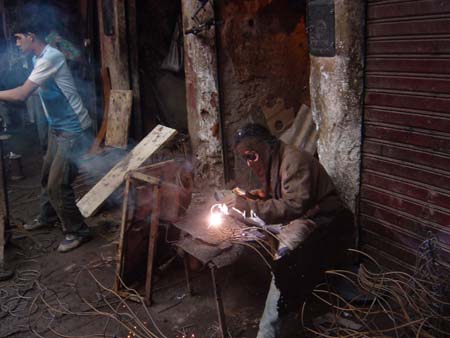 rafts
and seem very able to make the best of the space they have.
rafts
and seem very able to make the best of the space they have.
Interestingly, each family who lives here has a specific skill which has
remained in the family for multiple generations. We have seen many young men
and children participating in the production process. Mustapha told us that
the know-how is not written down - it's simply taught and passed down through
the generations.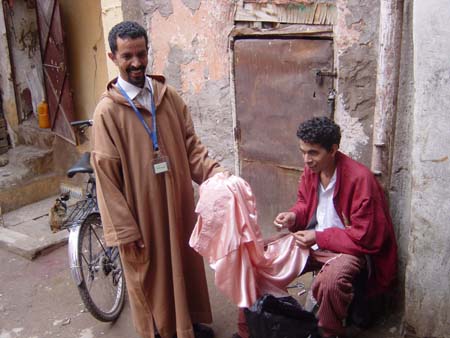
The Medina is divided into neighborhoods called quarters. Each quarter has five elements: a mosque, a public fountain for water, a public bakery, a Turkish hammam (bath) and a school. Each quarter is a community within the larger community of the Medina. Similar to our concept of neighborhoods, the quarters all have reputations in terms of the people who live there, the housing and their overall desirability. Surprisingly, there are over 900 quarters in the Medina, where over 600,000 people live and work.
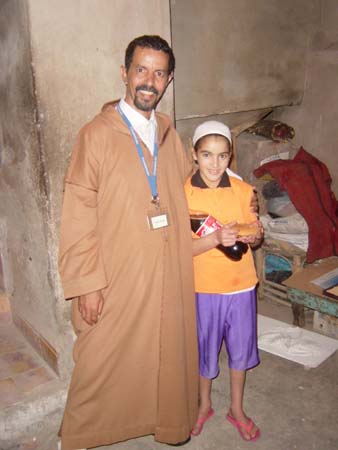 Mustapha
joked that there's now a sixth element that has become essential for each
quarter - the internet cafe. We walked into one such café, and although
it was very small, it looked just like the ones we've seen in so many other
cities.
Mustapha
joked that there's now a sixth element that has become essential for each
quarter - the internet cafe. We walked into one such café, and although
it was very small, it looked just like the ones we've seen in so many other
cities.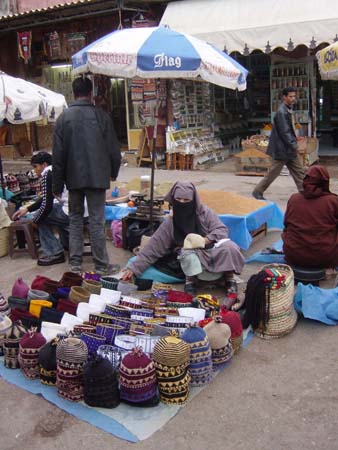
Mustapha took the time to talk to us about the changing place of women in Moroccan society. He showed the office of a lawyer who is a woman, and spoke of the increasing number of women professionals here. He told us that of the 220 members of Morocco's parliament, 35 of them are women. However, we noticed that there are few women in the workshops or working in the souqs. Mustapha said that many women generally work in their homes doing embroidery, knitting and carpet weaving.
We enjoyed walking through a "darb", which is where most residents of the Medina live. Darbs are large labyrinths of homes that are accessed through narrow alleys. Each darb has one entrance and many homes within. There are no windows to the outside, but many of the homes have open courtyards inside. The outsides of the darbs are quite plain but the insides are decorated - both our guides have commented that is consistent with the Islam belief that it is what is on the inside (in people's hearts and their homes) that matters.
 Once
inside the darb it is possible to wander for long periods through very narrow
passages from one person's home to another. The doors of each home often indicate
how wealthy a family is. Many families stay in one darb for multiple generations,
and extended families often share homes and resources. Muphasta told us that
average
Once
inside the darb it is possible to wander for long periods through very narrow
passages from one person's home to another. The doors of each home often indicate
how wealthy a family is. Many families stay in one darb for multiple generations,
and extended families often share homes and resources. Muphasta told us that
average 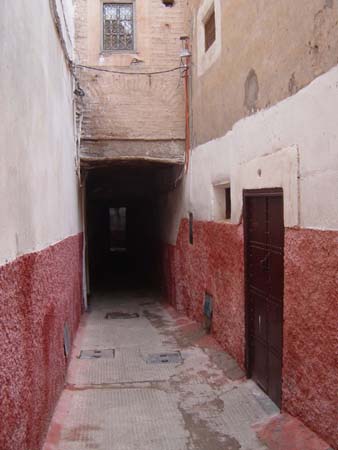 wages
here are approximately $200/month, barely enough to cover expenses. The rent
alone for a home in a darb can exceed $100/month. Today we also visited a
Riyah, a home for the more affluent. These homes are generally outside the
Medina, and recently are being converted into guesthouses that are lavishly
decorated and have beautiful courtyards.
wages
here are approximately $200/month, barely enough to cover expenses. The rent
alone for a home in a darb can exceed $100/month. Today we also visited a
Riyah, a home for the more affluent. These homes are generally outside the
Medina, and recently are being converted into guesthouses that are lavishly
decorated and have beautiful courtyards.
Some of the more expensive housing in the Medina is owned by foreigners (usually professionals) who have come to live in Marrakech. This has contributed to an increase in housing prices and made it increasingly difficult for local residents. Mustapha told us that in many homes, multiple generations of people all live together and share in the expenses.
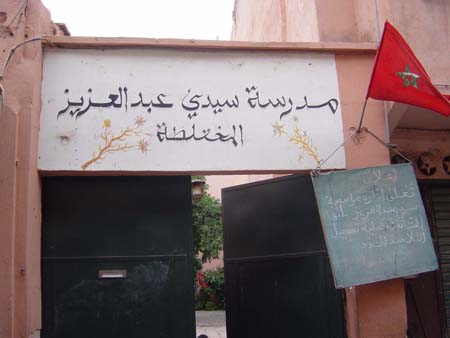 We
passed by several schools today (this picture shows an entrance to one), but
they are closed on Fridays because it's the Muslim holy day. While education
for children is now mandatory (and fully paid for by the government), this
law has only existed for approximately 10 years. This explains why the illiteracy
rate is still very high here. Many of the schools have begun to offer free
classes to the parents of the students in the evening. This is intended to
help Morocco's illiteracy problem.
We
passed by several schools today (this picture shows an entrance to one), but
they are closed on Fridays because it's the Muslim holy day. While education
for children is now mandatory (and fully paid for by the government), this
law has only existed for approximately 10 years. This explains why the illiteracy
rate is still very high here. Many of the schools have begun to offer free
classes to the parents of the students in the evening. This is intended to
help Morocco's illiteracy problem.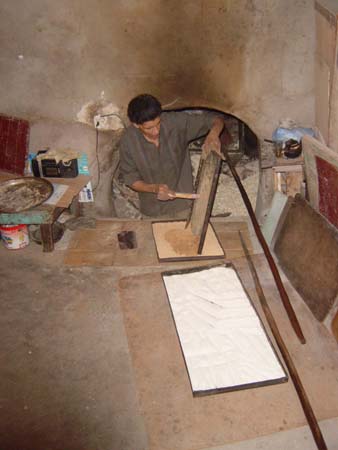
At one point, we saw a woman walking along the street who had obviously been drinking. Mustapha expressed concern over the large number of Muslims who frequent the bars of Marrakech, despite the fact that alcohol is forbidden by the Islamic religion. The bars are supposedly only for foreigners, but most of the customers are local residents. People can actually be fined if they are caught drinking, but this is apparently very rare.
We visited more markets and local bakeries. These were similar to those from yesterday, but it was good to meet new people and see more examples of these. Mustapha seemed to know every shopkeeper, and this was very helpful in allowing us to walk into the shops and interact with the people inside.
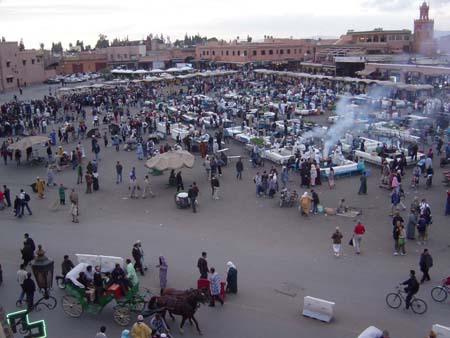
This evening we returned to the Djemaa el-Fna Square. Things were definitely livelier tonight, largely due to the better weather. Our first stop was in a café that overlooks the entire square. From here it was wonderful to observe all the activity going on below. The combination of sounds from the storytellers, snake charmers, musicians and food vendors is really amazing. As the sun began to set, the square became more crowded with local residents who we presume come here regularly to be entertained.
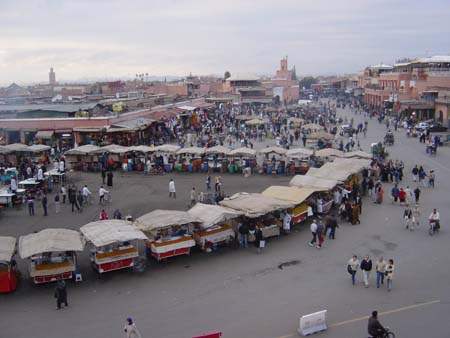
As we noted yesterday, the wonderful thing to us about the Djemaa el-Fna
Square is the fact that this place is clearly for the people of Marrakech.
We saw a few tourists here, but not many. In fact, after we left the café
and walked through the square, we found that the biggest crowds were the ones
gathered around story tellers, comics and theatric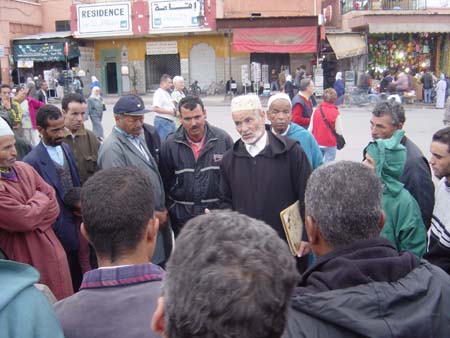 al
performers. The performers were all speaking in Arabic, so we couldn't even
begin to understand what was gong on! However, it was fun to observe the crowds
and their reactions. In particular, the storytellers seemed to have their
audiences totally immersed in their stories. Fascinating!
al
performers. The performers were all speaking in Arabic, so we couldn't even
begin to understand what was gong on! However, it was fun to observe the crowds
and their reactions. In particular, the storytellers seemed to have their
audiences totally immersed in their stories. Fascinating!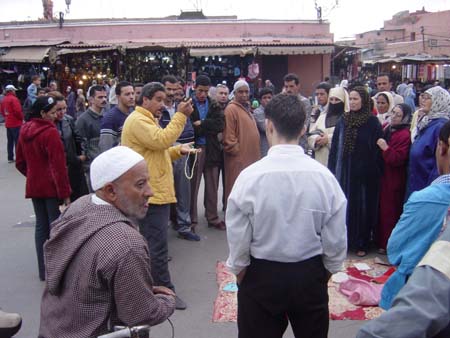
The one venue which is clearly oriented toward the tourists is snake charming.
There are several snake charmers here, and we stopped to watch and take pictures.
Mustapha told us that the poison has been removed from the snakes - this certainly
explains the willingness of the trainers to tease the snakes with their bare
hands and 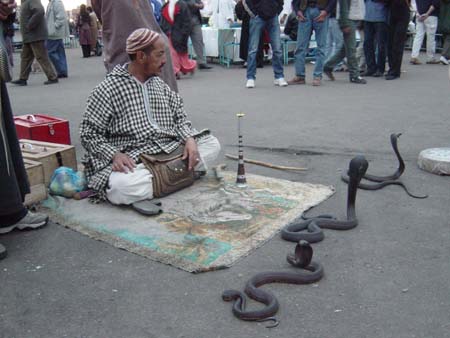 encourage
the snakes to strike at them. We assume that even with no poison, it's not
a good thing to be bitten by one of these guys…
encourage
the snakes to strike at them. We assume that even with no poison, it's not
a good thing to be bitten by one of these guys…
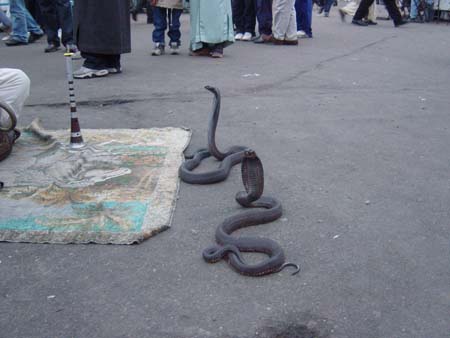
As we got ready to leave the Djemaa el-Fna, Mustapha showed us a plaque that
communicates what the square represents to the people of Marrakech. It also
tells of a special recognition that the square has received from UNESCO. The
words on the plaque say: "The cultural space of Djamaa el-Fna Square
has been proclaimed masterpiece of the oral and intangible heritage of humanity
by UNESCO. The Djemaa el-Fna square is situated in the heart of the medina.
This cultural and artistic crossroads is used not only as a meeting place
for local people, but also for storytellers, acrobats, 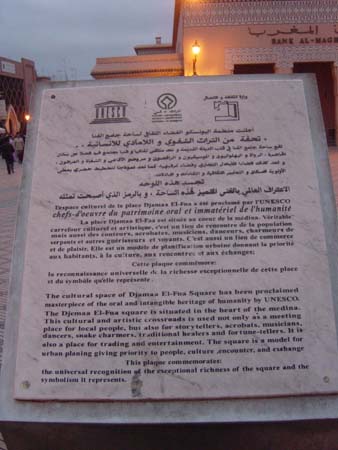 musicians,
dancers, snake charmers, traditional healers and fortune-tellers. It is also
a place for trading and entertainment. The square is a model for urban planning
giving priority to people, cultural encounter and exchange. This plaque commemorates
the universal recognition of the exceptional richness of the square and the
symbolism it represents."
musicians,
dancers, snake charmers, traditional healers and fortune-tellers. It is also
a place for trading and entertainment. The square is a model for urban planning
giving priority to people, cultural encounter and exchange. This plaque commemorates
the universal recognition of the exceptional richness of the square and the
symbolism it represents."
At dinner this evening, we had a family conversation about the amazing variety of places that we've seen. We're very happy that we made the decision to include locations such as Russia, Istanbul and now Marrakech. These have all been extremely different from Western Europe, and have added a wonderful dimension to our overall experience. Tomorrow we're headed on a day trip into the Atlas Mountains, where we'll stop and see some Berber villages and souks.
Distance Walked: 2.13 miles
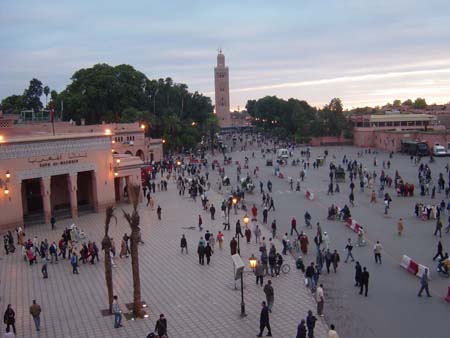
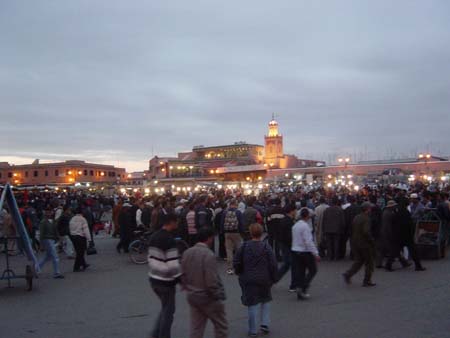
.
